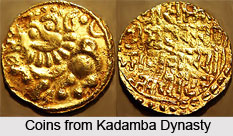 Kadambas of Goa are the offshoots of Kadamba dynasty. Later on they ruled from Chandor. According to the Talagunda inscription they are of Brahmin origin who descended from Mayurasharma. There are several myths surrounding their origin. It is considered that they are of Dravidian origin and were later included in the Vedic Brahamanical fold.
Kadambas of Goa are the offshoots of Kadamba dynasty. Later on they ruled from Chandor. According to the Talagunda inscription they are of Brahmin origin who descended from Mayurasharma. There are several myths surrounding their origin. It is considered that they are of Dravidian origin and were later included in the Vedic Brahamanical fold.
Kadamba Shasthadeva was appointed as Mahamandaleshwara of Goa by Chalukya king Tailapa II. The Kadambas were an alliance of the Chalukyas and helped them in defeating the Rashtrakutas as per the Savai vere inscription. Shashthadeva later on conquered the city of Chandrapur from the Shilaharas and established Goa Kadamba dynasty in 960 AD.
Goa had become very famous during the rule of Kadambas. During the administration of Kadambas Goa`s religion, culture, trade, arts flourished. Several Shiva temples were built as there were many rulers who were Shaivites. Titles like Konkanadhipati, Saptakotisha Ladbha Varaveera, Gopakapura varadhishva, Konkanmahacharavarti, Panchamahashabda were adopted by the rulers. The kings of Goa had marital relationships with the Kings of Saurashtra and even the local chieftains. They patronized Vedic religion and performed fire sacrifices like the horse sacrifice. Shaivism was popularised by them in Goa. Jainism was also propagated by them in Goa.
Their language of administration was Sanskrit and Kannada. However they also patronized Konkani and Marathi. Kannada language was introduced by them to Goa. This has influenced the colloquial Language of Goa. Scripts like Nagari script, Kadamba script, Halekannada script and Goykanadi scripts were popular. Kadambas ruled Goa for more than 350 years. They lost their kingdom to Yadavas of Devagiri. There are ruins of palaces, mansions, temples and markets still in Chandor Village.
This article is a stub. You can enrich by adding more information to it. Send your Write Up to content@indianetzone.com



















